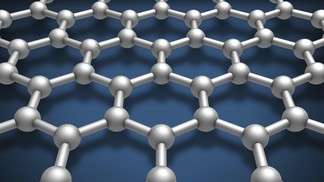Graphene multiplies the power of light

Could graphene turn light to electricity? Scientists have shown that graphene can convert a single photon into multiple electrons, showing much promise for future photovoltaic devices.
Graphene is a material that has gathered tremendous popularity in recent years, due to its extraordinary strength and light weight. It can be generated by literally peeling it off from graphite, or by growing it on top of various materials, which makes its production cost-effective. Studies have hinted that graphene can also be used as a photovoltaic material, turning light into electricity. Using a cutting-edge spectroscopic method, scientists at EPFL and collaborators have demonstrated that by absorbing a single photon, graphene can generate multiple electrons that have enough energy to drive an electrical current. The work is published in Nano Letters.
Graphene is fascinating in terms of fundamental physics, because it is better at conducting electricity at room temperature than e.g. copper, which makes it ideal for ultra-fast circuits. In addition, graphene has been shown to conduct electricity after absorbing light, which means that it could also be used in photovoltaic devices. But until now, graphene's potential for efficient light-to-electricity conversion was not well understood.
This is a challenging task as this conversion takes place on a femto-second scale (10-15 sec; a quadrillionth of a second), too fast for conventional techniques to detect electron movement. To overcome this obstacle, Jens Christian Johannsen from Marco Grioni's lab at EPFL, with colleagues at Aarhus University and ELETTRA in Italy, employed a sophisticated technique called "ultrafast time- and angle-resolved photoemission spectroscopy" (trARPES). The experiments were carried out at the world-renowned Rutherford Appleton Laboratory in Oxford.
With this method, a small sample of graphene is placed in an ultra-high vacuum chamber. The graphene is then hit with an ultrafast 'pump' pulse of laser light. This excites the electrons in graphene, "raising" them to higher energy states where they can actually drive an electrical current. While the electrons are in those states, the graphene sample is hit with a time-delayed, 'probe' pulse that literally takes a snapshot of the energy each electron has at that moment. The sequence is repeated rapidly for different time points, like a stop-motion movie, and captures the dynamics of the electrons in a live-action sequence.
One photon, many electrons
The scientists used "doped" samples of graphene, which means that they added or subtracted electrons from it by chemical means. The experiment revealed that, when doped graphene absorbs a single photon, this can excite several electrons and do so proportionally to the degree of doping. The photon excites an electron, which then rapidly "falls" back down to its ground state of energy. As it does so, the "fall" excites two more electrons on average as a knock-on effect. "This indicates that a photovoltaic device using doped graphene could show significant efficiency in converting light to electricity", says Marco Grioni.
The scientists have made the first-ever direct observation of graphene's photon-electron multiplication effect, which makes the material a very promising building block for any device that relies on converting light into electricity. For example, novel photovoltaic devices using graphene could harvest light energy across the entire solar spectrum with lower energy loss than current systems.
Building on their cutting-edge technology and experimental success, the scientists are now planning to explore similar effects in other two-dimensional materials, such as molybdenum disulphide (MoS2), a material that is already in the limelight for its remarkable electronic and catalytic properties.
More information: Johannsen JC, Ulstrup S, Crepaldi A, Cilento F, Zacchigna M, Miwa JA, Cacho C, Chapman RT, Springate E, Fromm F, Raidel C, Seyller T, King PDC, Parmigiani F, Grioni M, Hofmann P. "Tunable Carrier Multiplication and Cooling in Graphene." Nano Letters December 2 2014. DOI: 10.1021/nl503614v
Journal information: Nano Letters
Provided by Ecole Polytechnique Federale de Lausanne

















